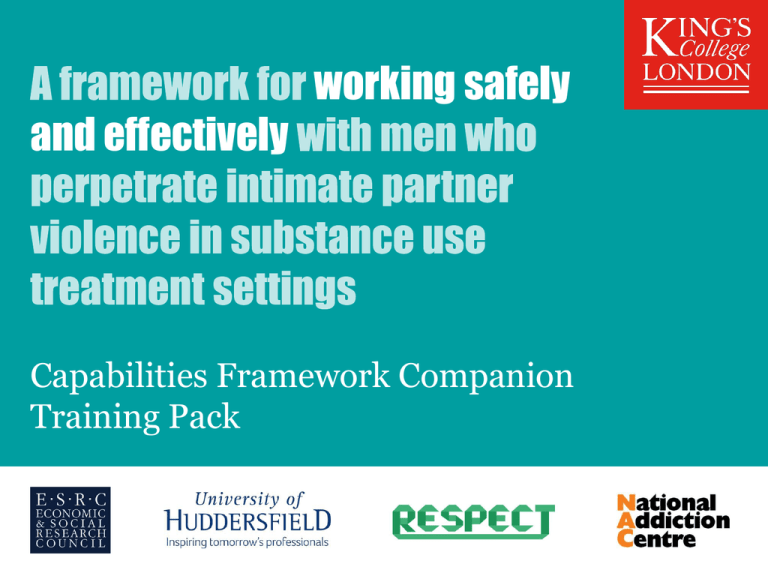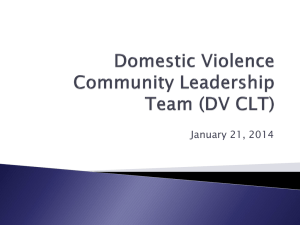
working safely
and effectively
Capabilities Framework Companion
Training Pack
Project information
Perpetration of intimate partner violence by males
in substance use treatment: a cross cultural
learning alliance - ES/K002589/1
Acknowledgments
This framework is an output of the bilateral project ‘Perpetration of
intimate partner violence by males in substance abuse treatment: a crosscultural research learning alliance’ funded by the Economic and Social
Research Council in the UK (ES/K002589/1).
We would like to acknowledge the contribution from members of the local
and international Learning Alliances of the bilateral project on developing
the framework.
We are also grateful to the key stakeholders and men in substance use
Aims of training
• Background to project
• Development of the framework
• Content
• How to use it
Background
•
The framework was developed as a product of the ESRC bilateral funded
project: ‘Perpetration of intimate partner violence by males in substance use
treatment: a cross cultural learning alliance’ ES/K002589/1
•
This was an alliance between the UK and Brazil of academics, practitioners,
voluntary organisations, charities, policy-makers and service users
•
The research examined and compared prevalence and cultural construction of
intimate partner violence perpetration by males attending treatment for
substance use in England and Brazil
•
In addition, government and local strategies, protocols and care pathways were
reviewed, and interviews with key stakeholders identified barriers and
facilitators to responding to intimate partner violence
•
These findings informed the development of the Capabilities Framework
The aim of this training
• This training is designed to introduce the Capability
Framework as a whole
• It is a chance to reflect on where your skills, knowledge
and values lie
• To recognise the importance of being able to detect,
discuss and act on potential or actual perpetration
within your role in substance use treatment services
• It’s an opportunity to consider your learning needs
Definition of ‘Intimate Partner Violence’
Intimate partner violence falls under umbrella of ‘domestic
violence and abuse’
For the purposes of the framework we are focusing on men
who perpetrate intimate partner violence which includes:
• Psychological
• Physical
• Sexual
• Financial
• Emotional
• Controlling behaviours
Nature and prevalence
• Distinct types of perpetrators have been distinguished. These can be described
as those who:
• Perpetrate severe and escalating forms of violence characterised by multiple
forms of abuse, terrorisation and threats, and increasingly possessive and
controlling behaviour on the part of the perpetrator, and;
• those who perpetrate a more moderate form of relationship violence, where
continuing frustration and anger occasionally erupt into physical aggression
(WHO, 2002)
• Perpetration of intimate partner violence is very common amongst men who use
substance use treatment
• Around 4 in 10 men have been physically or sexually violent towards their
partner in previous 12 months
• Findings from this study (Gilchrist el al, 2015) found that 75% of men attending
services for alcohol and/or drug treatment had ever perpetrated intimate
partner violence
Intimate partner violence
Intimate partner violence is associated with:
• Younger age
• Adverse childhood experiences
• Substance use
• Psychological problems
• Anger expression
• Sexist attitudes
• Support of gender specific roles
However, relationship is likely to be complex ‘nested
ecological theory’: interplay of social, biological, psychological
and environmental factors (Dahlberg & Krug , 2002)
Ecological model
SOCIETAL
• RAPID SOCIAL CHANGE
• GENDER, SOCIAL AND
ECONOMIC INEQUALITIES
• POVERTY
• WEAK ECONOMIC SAFETY
NETS
• POOR RULE OF LAW
• CULTURAL NORMS THAT
SUPPORT VIOLENCE
COMMUNITY
RELATIONSHIP
INDIVIDUAL
• POVERTY
• HIGH CRIME LEVELS
• HEIGH RESIDENTIAL
MOBILITY
• HIGH UNEMPLOYMENT
• LOCAL ILLICIT DRUG TRADE
• SITUATIONAL FACTORS
• POOR PARENTING PRACTICES
• MARITAL DISCORD
• VIOLENT PARENTAL
CONFLICT
• LOW SOCIOECONOMIC
HOUSEHOLD STATUS
• FRIENDS THAT ENGAGE IN
VIOLENCE
• VICTIM OF CHILD
MALTREATMENT
• PYSCHOLOGICAL/PERSONALI
TY DISORDER
• ALOHOL/SUBSTANCE ABUSE
• HISTORY OF VIOLENT
BEHAVIOUR
World Health Organisation www.who.int/violenceprevention/approach/ecology/en/
Exercise 1
Scenario
Dave is waiting for his wife Sarah to come home. He’s been drinking since
lunchtime in the pub, and has carried on drinking at home. By 11 p.m. he’s
very drunk. She’s late and he’s worried and cross that she hasn’t
responded to his texts. When she eventually gets in (an hour and a half
later than she was expected), he starts quizzing her – where has she been,
why didn’t she text, who was she with? She dismisses his concerns; her
battery had died, there was bad traffic, it was nothing, and an argument
builds. Sarah finally gets fed up of his constant questions and shouts at
him “it’s none of your f***ing business where I’ve been”. Dave grabs her
by the arms, throws her into the wall, knees her in the groin and walks
away.
Exercise 1
Group discussion
• How did you feel about Dave and Sarah’s behaviour
in the scenario?
• What role do you think substance use played in the
scenario?
• Apart from actual physical violence, in what other
ways does intimate partner violence and abuse
manifest?
Exercise 2
Your experiences of working with perpetrators
What has been your experience of working with men
who perpetrate intimate partner violence?
Consider:
• how it has manifested
• Issues for yourself as a worker
• Issues for the partner and children (victims)
• Issues for the team and external agencies
It’s not just physical
• It’s not just physical harm! Think about it as a broader
set of behaviours (often co-occurring)
• Verbal aggression (shouting, swearing, verbal threats)
• Psychological abuse (belittling, humiliating)
• Manipulative behaviour (e.g. emotional blackmail,
jealousy)
• Controlling (keeping control of money, isolating from
friends, family, work)
• Always consider the impact of behaviours on the victim
not just the immediate physical impact of violence but
also in terms of perpetuating substance use as a way of
coping, as well as long term impact on mental and
physical health.
Thinking about the case study again
How do you feel Dave’s behaviour will impact on Sarah in the
future? Violence doesn’t just affect a person at the time, it
also affects the victim on a longer term basis.
For example:
• She may be scared of him and be hyper-vigilant for him
becoming aggressive
• She may be very wary around him and modify her
behaviour when he is drinking
• Making sure she is back on time?
• Maybe avoiding going out all together?
• Apologising, placating?
Perpetrators may explain or minimise
• They excuse or minimise the impact (eg only pushed her a
couple of times)
• Blame the victim (violence as a response to
her ‘unreasonable‘ behaviour)
• It was out of character and as a result of excessive substance
use or other critical situation (it was the drink talking, I’m
not normally like that…)
• Reflect on how much we may inadvertently collude with this
if we see intimate partner violence as:
• Only extreme physical violence
• Substance use is to blame
• The person was pushed by the behaviour of the victim
• The victim may also blame themselves and minimize
impact
Key messages
• All intimate partner violence and abuse is
unacceptable behaviour whatever the context in
which it occurs (i.e. drunk, sober, perceived
provocation etc.)
• The priority is always the safety of the victims
(including children who may be witnesses and/or
victims too)
• Bear in mind that around 40% of perpetrators are
also violent to their children
Facilitating disclosure
• Ask everyone!
• Create a culture within the service where violence is
discussed – not just with victims but also with
potential perpetrators
• Skills- creating a therapeutic relationship with
trust, respect and honesty but also have clear
boundaries
• Reflect on your own feelings about asking about
perpetration- confidence, comfort, anxieties you
may have
Exercise 3
Raising the topic
Consider:
• In working with people who use substances what
sensitive topics do you discuss?
• What skills do you use for this? What works well?
• What are you main concerns about asking about
perpetration of intimate partner violence?
• Could the skills from other “sensitive” areas be
transferable to this topic?
Gathering Information about risks
• Use existing risk assessment tools to gather
information
• Disclosure is more likely within a trusting
therapeutic relationship
• Think about factors that indicate increased risk,
including:
• Recent pregnancy
• Increased severity of intimate partner violence
• Victims own fear of increased harm
• Sudden change of circumstances- a relapse, loss
of job, housing etc.
Exercise 4
Dealing with disclosure
What would you do with a disclosure of perpetration.
Consider:
• How this would be managed in the 1:1 setting?
• Within your wider team
• With the victim(s) (if known)
• With external agencies
• In what circumstances would you breach client
confidentiality?
Knowing what to do with disclosure
• Never deal with disclosure in isolation- always seek
support and supervision about any disclosure of
perpetration of intimate partner violence
• Communication within teams and appropriate
external agencies
• Know your local providers statutory processes and
care pathways
Knowing what to do with disclosure
• Maintain optimism – using disclosure to promote a
positive view of the future and opportunity for
change
• Re-establish common ground – confirm your
commitment to work towards shared goals of
recovery and safe relationships (most perpetrators
want to find new solutions to intimate partner
violence too)
Commitment to professional development
• Reflect on and develop practice – seek and use
supervision
• Individual supervision
• Team meetings
• Training- accessing and requesting learning
opportunities
• Formal
• informal
Commitment to professional development
• For each capability there is a self-rating for how strongly you
feel you possess skills, knowledge and values for each one:
From 1 = strongly disagree to 5 = strongly agree
• There is also a space to write a learning action point and
time scale (make your goals SMART)
• Be creative about how you can develop your capabilities
• Can you spend a day in a perpetrator service?
• Consider inviting an external agency to provide training
on IPV, and in return your agency could provide the IPV
agency with training on substance use
Team checklist
• This is to assess the team culture as a whole
• Addresses five areas
• Report supporting evidence that this is already
attended to
• Identify need and action plan for areas that need to
be developed
Further resources
•
•
•
•
•
•
•
•
•
•
For advice on perpetrators (including case discussion) and information about local programmes
call the Respect phone line http://www.respect.uk.net/contact-us
Risk assessment for victims: http://www.dashriskchecklist.co.uk
Risk assessment for perpetrators http://respect.uk.net/work/work-perpetrators-domesticviolence/risk-assessment/
Stella Project Complicated matters: a toolkit and e-learning programme addressing domestic and
sexual violence, problematic substance use and mental ill-health
http://www.avaproject.org.uk/our-resources/good-practice-guidance--toolkits/complicatedmatters-stella-project-toolkit-and-e-learning-(2013).aspx
Adult Safeguarding Responsibilities The Care Act 2014
http://www.legislation.gov.uk/ukpga/2014/23/contents/enacted
https://www.gov.uk/government/uploads/system/uploads/attachment_data/file/366087/Facts
heet_7_-_Safeguarding.pdf
Social Care Institute for Excellence Resources on Adult Safeguarding
http://www.scie.org.uk/adults/safeguarding
Multi-Agency Public Protection Arrangements (MAPPA)
https://www.gov.uk/government/publications/multi-agency-public-protection-arrangementsmappa--2
National Institute for Health and Care Excellence Guidance on domestic violence and abuse
https://www.nice.org.uk/guidance/ph50
National Centre Education and Training in Addictions “Can I Ask?” An alcohol and drug
clinician’s guide to addressing family and domestic violence
http://nceta.flinders.edu.au/files/2713/6615/8232/EN488_2013_White.pdf
Contact details/for more information
Dr Gail Gilchrist
National Addiction Centre
London SE5 8BB
+44 (0)20 7848 0646
gail.gilchrist@kcl.ac.uk
www.kcl.ac.uk/ioppn/depts/addictions/research/drugs/bilaterallearningalliance.aspx
© 2015 King’s College London. All rights reserved


